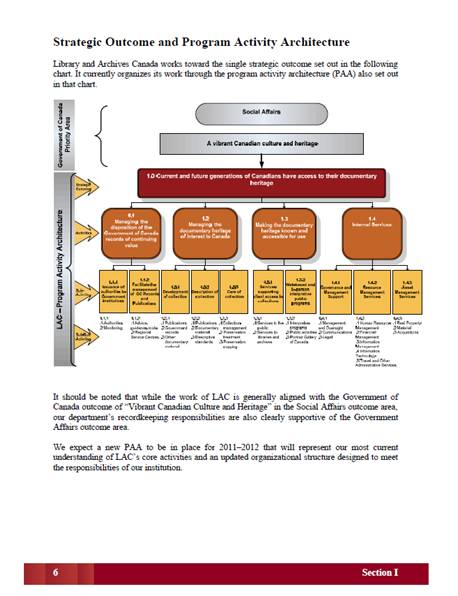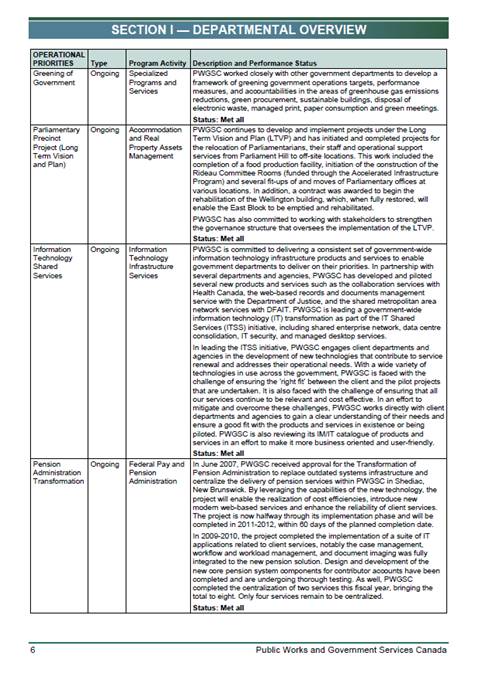Common menu bar links
Breadcrumb Trail
ARCHIVED - Performance Reporting: Good Practices Handbook 2011
 This page has been archived.
This page has been archived.
Archived Content
Information identified as archived on the Web is for reference, research or recordkeeping purposes. It has not been altered or updated after the date of archiving. Web pages that are archived on the Web are not subject to the Government of Canada Web Standards. As per the Communications Policy of the Government of Canada, you can request alternate formats on the "Contact Us" page.
Clearly present the program activity architecture
Explaining the critical aspects of planning and performance begins with their identification. In large part, articulating the department’s core objectives and the key results to which it is committed will achieve this first step. Because the MRRS guides decision making and is the basis for managing for results, the strategic outcomes and program activity architecture (PAA) will serve as the framework through which to explain the department’s critical aspects of planning and performance.
Consequently, presenting a clear PAA is key for putting this principle into practice. It should be clear in the report what the strategic outcomes and program activities are and how they are connected. Presenting the PAA visually and through discussion is an effective way of communicating this information to readers. The DPR should use the same PAA as the one presented in the corresponding RPP. In exceptional circumstances, a new PAA may be used, subject to Treasury Board approval. Should this occur, it is important to provide a crosswalk and discuss the impact on performance.
Good practice: Clearly present the PAA (i.e., development of a PAA along with its clear use).
PAAs have stabilized since the inception of the Policy on Management, Resources and Results Structures (MRRS) in 2005, with 90 per cent of departments presenting a clear PAA in the DPRs. The example below demonstrates the maturity of PAA reporting structures and the development of a PAA along with its clear use.
Why is the following a good practice? The DPR presents a clear inventory and logical relationship of its strategic outcome and program activities. The PAA is at a sufficient level of materiality to reflect how a department allocates and manages the resources under its control to achieve intended results.
Good practice example: Library and Archives Canada DPR 2009–10

Discuss priorities within the context of the MRRS
Certain items may be identified as taking precedence over others in order for progress to be made toward the strategic outcomes; these may change from year to year or within a single reporting cycle. Any priorities identified in the RPP and DPR should be discussed within the context of the MRRS, and the linkages between priorities and program activities should be clearly demonstrated. Specifically, how the priorities are expected to contribute to the strategic outcomes should be discussed so that readers understand their relative importance.
Good practice: Discuss priorities within the context of the MRRS.
Why is the following a good practice? The linkages between priorities and program activities are clear. Detail is provided on the performance status for meeting expected results and the corresponding departmental priorities.
Good practice example: Public Works and Government Services Canada DPR 2009–10

